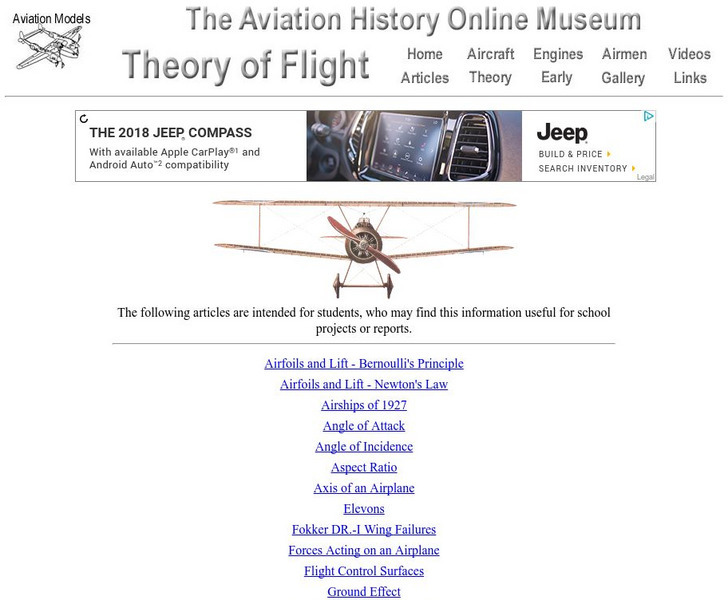Smithsonian Institution
Korean War
North and South Korea: two regions divided. The story of the Korean War describes the events that occurred when these two regions' ideologies clashed. The resource uses various images and descriptions of artifacts, in addition to...
NASA
Nasa: Beginner's Guide to Aerodynamics
Includes exhaustive information and a wealth of activities pertaining to aerodynamics and the physics of flight.
NASA
Nasa: Aerodynamics Index
Are you studying or teaching Aerodynamics? This page acts as an index to all the terminology related to this topic. Clicking on any title will open a page with a colored slide and a scientific explanation of the contents. Animated,...
PBS
Pbs: Wgbh: Nova: The Colditz Glider: Airfoil Aerodynamics
Examine what science lies behind keeping flying machines in the air. The wings angles, shape and placement, speed and what else must be considered in the development of device?
Exploratorium
Exploratorium: The Science of Sports Cycling
A detailed look at the aerodynamic principles associated with cycling. Good science and even better web page design. Includes an online calculator that allows the user to calculate the aerodynamic drag and propulsive power of a bicyclist...
Other
Aviation Internet Group: Aviation Theory
Collection of articles ranging from basic to advanced on aerodynamics theory.
NASA
Nasa: Beginner's Guide to Aeronautics
A website that catalogs information and activities for how airplanes work. The concept of aerodynamics is explained in full detail.
Other
Ken Blackburn: Paper Airplanes
Information on paper airplane designs, history, and contests. Click on "Paper Airplane Aerodynamics" for an analysis of the world record holding paper airplane design.
NASA
Nasa: Beginner's Guide to Aerodynamics
This site from NASA uses a colorful graphic to illustrate why objects reach terminal velocity. Provides equation for the terminal velocity of an object. Graphic is accompanied by a simple explanation.
Other
Virginia Space Flight Academy: Summer Residence Camps
Watch campers count down for take-off and the ultimate rocket launch during this summer space camp experience. Read about programs offered including spaceships, aerodynamics, microgravity, robotics, rocket assembly and launching,...
NASA
Beginners Guide to Model Rockets
This resource provides numerous links that will give teachers and students an overview of rocketry.
Exploratorium
Exploratorium: Sport Science
In this colorful and interactive resource, students can learn about the science behind baseball, hockey, cycling, skateboarding, and surfing.
PBS
Pbs Nova: Pilot the Wright Brothers' Flyer
In this interactive, find out how the Wright brothers' design of the first flyer provided lift and speed, and allowed the pilot to make adjustments in response to changes in wind speed and direction.
Other
All Star: Airfoils
The basic theories of aeronautics are explained through several airfoil activities and animations. Click on Level 2 or 3 for an easier reading level.
MadSci Network
Mad Scientist Network: How Do Planes Fly Upside Down?
Question and answer regarding the physics principles that apply to a plane flying upside down.
National Academy of Engineering
Greatest Achievements: Airplane
This page provides an overview of the history behind one of the greatest engineering innovations of all time:the airplane. There is also a timeline showing its development.
PBS
Pbs: American Experience: The Wright Stuff
Companion website to the PBS documentary on the Wright Brothers and their contributions to aviation.
PBS
Pbs Teachers: Model Rockets
Explore how the materials and shape of a rocket affect its performance. Watch kids use the scientific method to figure out how to build a model rocket that will reach 1,600 feet.
Other popular searches
- Air and Aerodynamics
- Swimming Aerodynamics
- Aerodynamics of an Airplane
- Airplanes and Aerodynamics
- Aerodynamics Lift
- Helicopter Aerodynamics
- Train Aerodynamics
- Aerodynamics Free
- Aerodynamics of Flaps
- Aerodynamics Lift.
- Flying Disk Aerodynamics
- Aerodynamics of a Wheel

















